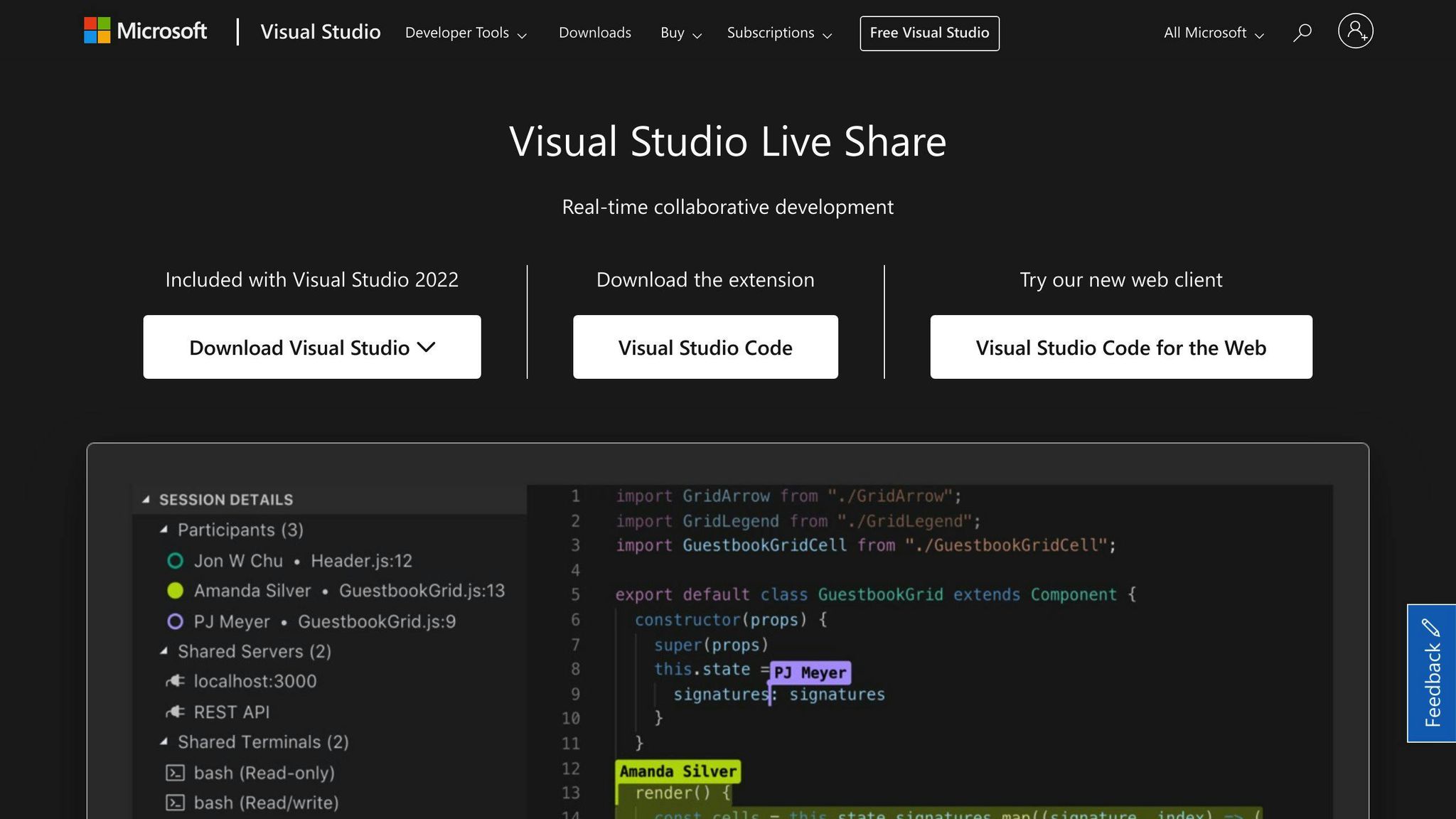


Learn about the collaboration features of Visual Studio Code (VSC) using Live Share for real-time code editing, debugging, and sharing. Discover how to set up sessions and use key features for effective teamwork.
Visual Studio Code (VSC) is a powerful, free coding editor that supports collaboration, making it easier for developers to work together from anywhere. Here's what you need to know:
- Live Share: Allows real-time code editing, debugging, and sharing command lines and servers with your team.
- Built-in Git support: Manage code changes directly within VSC.
- Extensibility: Enhance VSC with extensions for code review, chatting, and more.
Before starting, ensure you have a Microsoft or GitHub account, the latest VSC version, and the Live Share extension pack installed. Live Share enables you to co-edit, co-debug, share servers and terminals, simplifying remote teamwork. Here's how to set up and use its key features for effective collaboration:
- Download and install the Live Share extension pack.
- Start or join a collaboration session, sharing or entering a session link.
- Manage session settings to control collaborator permissions.
- Share servers and terminals for full project access.
Use cases include onboarding, mentoring, remote collaboration, code reviews, technical interviews, and education. VSC with Live Share turns coding into a collaborative and interactive experience, regardless of physical location.
Key Collaboration Features
Live Share is a tool you can add to Visual Studio Code that lets you work on code with other people in real time, even if you're not in the same place. Here's a look at what it offers:
Live Share Extension

The Live Share Extension Pack makes it possible for you and your teammates to edit, debug, and use terminals together. It's like being in the same room, working on the same project, even if you're miles apart.
Co-editing
With this extension, you can both work on the same file at the same time. You'll see where the other person is typing and what they're selecting, which makes it easier to talk about and work on the code together.
Co-debugging
Live Share turns fixing bugs into a team activity. Everyone can see what's going on, check out variables, add breakpoints, and step through the code together, making it easier to solve problems.
Share Server / Share Port
If you need to share access to web servers or databases while you work, Live Share lets you do that. It connects a port on one person's computer to others in the group, so everyone can access the necessary resources without hassle.
Share Terminals
You can also share access to the command line with Live Share. This means you can run tests, build your project, or do anything else that needs a terminal, together. You can set it so others can just watch, or they can type commands too.
These features make Live Share a great way to work on code with others, whether you're in different parts of the world or just working from home. It's perfect for team projects, helping someone out, or learning from each other.
Setting Up a Collaboration Session
Step 1: Download the Extension
First, you need the Live Share extension pack to work together in VS Code. Here's how to get it:
- Open the Extensions view in VS Code (
Ctrl+Shift+Xon Windows/Linux,Cmd+Shift+Xon Mac) - Type "Live Share Extension Pack" in the search box
- Click Install
After installing, you'll see a Live Share icon at the bottom.
Step 2: Share and Join a Session
To start sharing your code:
- Click the Live Share icon at the bottom
- Pick Start Collaboration Session
- Copy the link it gives you and send it to your team
To join someone else's code:
- Click the Live Share icon
- Select Join Collaboration Session
- Paste the link from the host
Guests will automatically see what the host sees. To do your own thing, just start clicking or typing.
Step 3: Limit Collaborators
If you're hosting, you can decide what others can do:
- Click the Live Share icon
- Go to Session Settings
- Change permissions like who can edit or use the terminal
This is handy if you want people to watch but not touch.
Step 4: Share a Server
You can let others use your local servers too:
- Click the Live Share icon
- Hit Share Local Server
- Pick the server port you want to share
Everyone in the session can access this server as if it were their own.
Step 5: Share a Terminal
Let others see or use your command line by sharing a terminal:
- Right-click a file and choose Share Terminal
- Decide if others can just look or also type
This way, you can work on commands, tests, or builds together.
sbb-itb-bfaad5b
Use Cases
Visual Studio Code's collaboration features make it easy for developers to work together, no matter where they are. Here's how people usually use these tools:
Onboarding New Team Members
Live Share is perfect for helping new people on the team get up to speed. An experienced team member can start a session to show a new developer around the code, explain how things are done, and even let them try making changes.
Mentoring & Pair Programming
A more experienced developer can use Live Share to help a newer developer learn. They can solve problems together, look at code changes, talk about different ways to do things, and learn good coding habits. The person hosting can control whether the other person can make changes.
Remote Collaboration
For teams that work from different places, Live Share lets people program together without the need to share screens. This means they can work directly in VS Code and use shared servers and terminals to access what they need without leaving the app.
Code Reviews
Doing code reviews is simpler with Live Share. Instead of just leaving comments on code changes, reviewers can go through the code together in real time. The person hosting the review can set who can make changes to keep things organized.
Technical Interviews
Interviewers can use Live Share for coding tests during interviews. This gives a more accurate picture of a candidate's skills in debugging, testing, and organizing code. They can set editing permissions to prevent cheating.
Education/Training
Teachers can use Live Share for live lessons and demonstrations. Students can practice coding in a controlled setting. The teacher can turn editing on or off, depending on the activity. Shared servers let everyone access the same resources.
Live Share makes working together smooth and straightforward, fitting a wide range of team needs.
Conclusion
VS Code has some really helpful tools for working together, and Live Share is one of the best for team projects. It lets people code together in real time, even if they're not in the same place. Here's what it does:
- Helps new team members get started: If you're new, someone with more experience can show you around the code, explaining how things work as you go.
- Makes mentoring easy: Experienced coders can watch and help less experienced ones, sharing tips and tricks.
- Improves working from home: Teams spread out in different places can work on the same project just like they would in an office. Everyone can use their own setup but still access the same tools and information.
- Speeds up reviewing code: Instead of just leaving comments on someone's code, you can go through it together and make changes on the spot.
- Makes interviews better: During interviews, you can see how well someone codes in real life by giving them tasks and watching how they solve them.
- Great for teaching coding: Teachers can show coding live, and students can follow along and practice in a setup that's controlled by the teacher.
In short, VS Code lets you work closely with your team, no matter where everyone is. You can set up who can do what, making sure that everyone has the right access. With Live Share, it's like everyone's working side by side, even when they're far apart.
Related Questions
How do you collab with VS Code?
To work together in VS Code, click the Live Share icon at the bottom or press Ctrl+Shift+P (Windows/Linux) or Cmd+Shift+P (Mac) on your keyboard. Choose "Live Share: Start collaboration session (Share)". The first time you do this, you might see a message asking if it's okay to let Live Share use your internet connection.
What are the features of VS Code?
VS Code has lots of cool tools, like:
- Helping you fix mistakes in your code
- Making your code colorful so it's easier to read
- Suggesting how to finish your code lines
- Handy shortcuts for code
- Helping you tidy up your code
- Letting you work with Git, a way to keep track of code changes
- Adding more tools through extensions
It's really good for writing and fixing code, and you can make it even better by adding extensions.
Does Visual Studio support collaboration?
Yes, Visual Studio lets you work on code with others in real time with something called Visual Studio Live Share. It doesn't matter what kind of code you're working on; you can write and fix it together.
What is the collaborator plugin in Visual Studio Code?
The Collaborator plugin lets your team:
- Point out mistakes and talk about code as you're working
- Set up code reviews and choose who should join
- Connect to other tools like JIRA, GitHub, and TFS
It makes it easier to look over code together by bringing other tools into VS Code.

.png)








